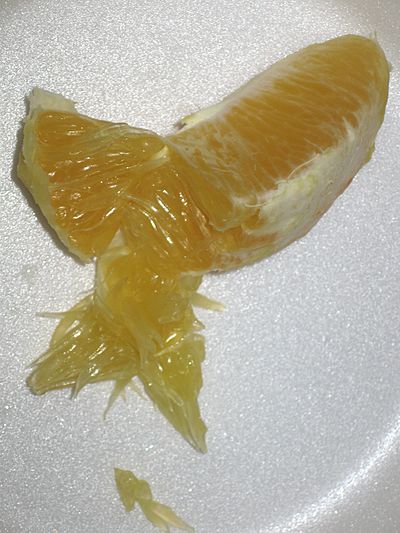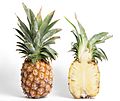Pulp (fruit) facts for kids

The pulp of a citrus fruit are the stringy content of the fruit’s endocarp. The pulp contains the juice of the fruit. The pulp is usually removed from fruit juice by filtering it out.
The color of the pulp can change, depending on the species and the ripening stage. Usually, it has the color of the fruit's peel.
The juiciness of the pulp depends on the species, variety, season, and even the tree on which it grew.
Related pages
Images for kids
-
Various culinary fruits
-
Caraway fruits. A common mistake is to call these and similar ones "seeds".
-
Pomegranate display of the exocarp (right) and seeds and edible sarcotesta (left)
-
An arrangement of fruits commonly thought of as culinary vegetables, including corn (maize), tomatoes, and various squash
-
Dewberry flowers. Note the multiple pistils, each of which will produce a drupelet. Each flower will become a blackberry-like aggregate fruit.
-
A dry simple fruit: milkweed (Asclepias syriaca); dehiscence of the follicular fruit reveals seeds within.
-
Strawberry, showing achenes attached to surface. Botanically, strawberries are not berries; they are classified as an aggregate accessory fruit.
-
Flower of Magnolia × wieseneri showing the many pistils making up the gynoecium in the middle of the flower. The fruit of this flower is an aggregation of follicles.
-
Detail of the raspberry flower: there is a clustering of pistils at the center of the flower. (A pistil consists of stigma, style, and ovary.) The stigma is the apical (at the apex) nodule that receives pollen; the style is the stem-like column that extends down to the ovary, which is the basal part that contains the seed-forming ovule.
-
Lilium unripe capsule fruit; an aggregate fruit.
-
The fruit of a pineapple includes tissue from the sepals as well as the pistils of many flowers. It is a multiple-accessory fruit.
-
Comparing fresh fruits for fiber, potassium (K), and vitamin C. Each disk-point refers to a 100 g serving of the fresh fruit named. The size of the disk represents the amount of fiber (as percentage of the recommended daily allowance, RDA) in a serving of fruit (see key at upper right). The amount of vitamin C (as percent RDA) is plotted on the x–axis and the amount of potassium (K), in mg on the y–axis. + Bananas are high in value for fiber and potassium, and oranges for fiber and vitamin C. (Apricots are highest in potassium; strawberries are rich in vitamin C.) Watermelon, providing low levels of both K and vitamin C and almost no fiber, is of least value for the three nutrients together.
-
Porcelain vine is usually planted for its showy, colourful berries.
-
In the noni, flowers are produced in time-sequence along the stem. It is possible to see a progression of flowering, fruit development, and fruit ripening.
See also
 In Spanish: Fruto para niños
In Spanish: Fruto para niños



















